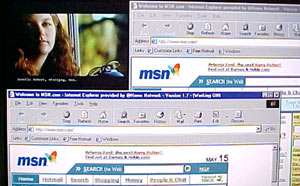External Features The
150MP breaks new ground on several fronts, not the least is the choice of
colour and design it uses. The Syncmaster uses a two-tone, silver and navy-blue casing
which is quite good at attracting attention. The power on/off switch
is back-lit green or orange depending on the status of the display,
and the rest of the control buttons on the front panel are touch sensitive. That means each of the eight control buttons
will only respond to direct contact with a finger. A very cool feature that
gives the display a high-tech James Bond feel. Four
small status LED's tell the user what signal the display is set for; PC,
V1 (S-Video), V2 (RCA), Cable (TV) and a few variants for picture in picture.
Adjusting the display
itself
The range
of adjustments the panel can accommodate are somewhat limited compared to other displays
we have looked at previously. The LCD only tilts back 15 degrees, and
will not tilt forward more than about 2 degrees by the looks
of it. Since the entire stand is part of the panel, there is no need for
a pivot mechanism.
The wonders of a built-in TV-tuner
It's
really quite a change to watch TV on a flat screen. Having been bread to accept
my favorite television programs are always delivered on
a slightly curved screen the change is a substantial one the my eyes haven't quite
become accustomed to. The 150Mp offers users the miracles of the V-chip along with
full cable channel support for both North America and
Japan. Since TV signals
operate at a lower resolution than computer displays, the shrunken-down television picture is generally
better quality in this regard.
With regard to the picture in picture capabilities it
is important to note that the feature is completely removed from the computer, or video
card. Everything happens right inside the display so no extra load is forced upon the
processor or video card whatsoever.
|
Picture in Picture:
Small Image |
 |
With PIP you can easily keep an eye on the TV
as you work away. The picture size in this setting is a
bit small to watch a program with, but a larger full-size setting will easily accommodate most
people. Also remember the audio from the TV will automatically come
through the built-in speakers too. |
How
well does the LCD panel display television pictures you wonder? Well good
question. Keeping in mind that most LCD panels are limited to displaying just 16.7
million colours you might think that the quality and vibrancy of the picture
would suffer. As far as most people are concerned there is virtually no
difference between watching a television show on a cathode-ray tube TV verses that of a show on a
LCD panel.
Is an LCD-TV better than a CRT-TV?
With the help of some good observation skills we were able
to pick out just one area in the quality of LCD displays that
differed from a standard TV.
A CRT-based display shows the transition from a
dark colour to a lighter shade as a very consistent transition. Whereas an LCD display
will sometimes show the same image in a more stepped fashion. The effect is
very slight, but if you compare two identical screens you can see some
'colour stepping' on an LCD display.
